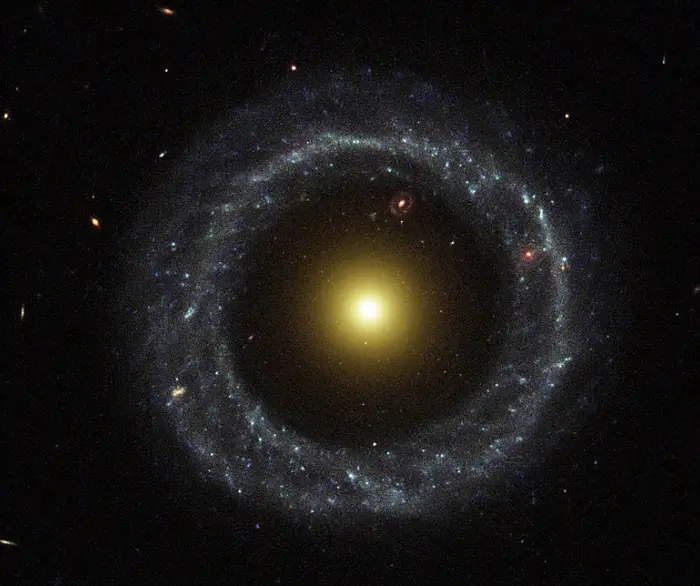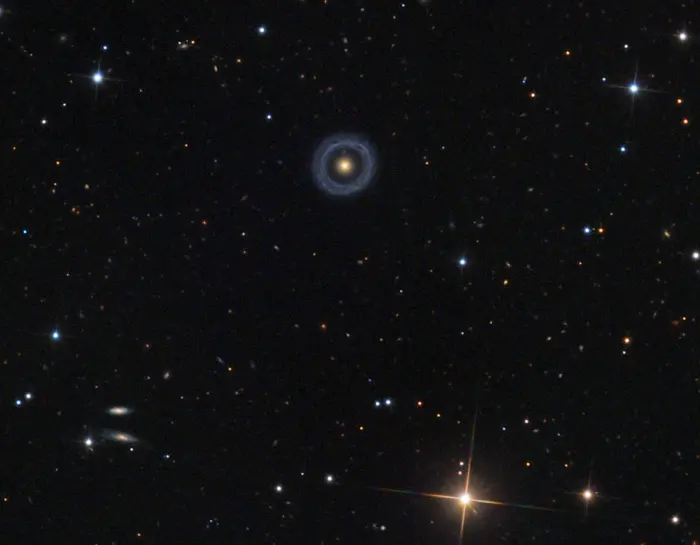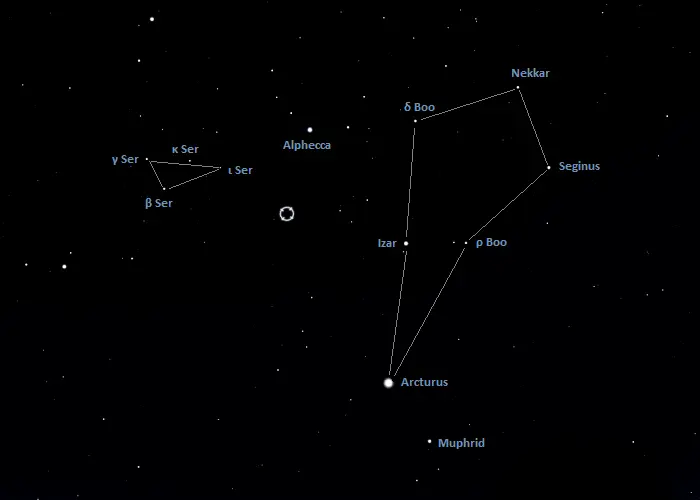Hoag’s Object is a ring galaxy located about 612.8 million light-years away in the constellation Serpens. Recognizable for its nearly perfect ring shape, the galaxy was named after Arthur Hoag, the astronomer who discovered it in 1950. The galaxy is 121,000 light-years across and contains about 8 billion stars. It has a mass of 700 billion Suns and shines at magnitude 16.2.
Hoag’s Galaxy is a unique example of what came to be known as Hoag-type galaxies. It has an almost perfectly symmetrical ring of luminous blue stars surrounding the older yellow nucleus. The region between the ring of young stars and the galactic nucleus may be home to faint star clusters that almost evade detection.
The core is dominated by much redder stars that appear to be much older. The gap between the two stellar populations – the stars in the ring and those in the core – appears almost completely dark. It gives an image of an elliptical galaxy nucleus that sits isolated in space and is surrounded by a bright ring that hovers around it in a spiral-like pattern at a baffling separation of tens of thousands of light-years.

A nearly perfect ring of hot, blue stars pinwheels about the yellow nucleus of an unusual ring galaxy known as Hoag’s Object. This image from NASA’s Hubble Space Telescope captures a face-on view of the galaxy’s ring of stars, revealing more detail than any existing photo of this object. The image may help astronomers unravel clues on how such strange objects form. Image credit: NASA and The Hubble Heritage Team (STScI/AURA); Acknowledgment: Ray A. Lucas (STScI/AURA)
American astronomer Arthur Hoag, who discovered the galaxy in 1950, initially described the object as a “perfectly symmetrical planetary nebula” with a perfect halo, bluer than the nucleus. As an alternative, he proposed that the object may be a “new species among the ‘pathological’ galaxies” or, less likely, a gravitational lens, i.e. an optical illusion caused by a high mass object (the core) bending and magnifying the light of a more distant background object (the ring).
The origin of the outer ring structure is still uncertain. The more famous Cartwheel Galaxy, a ring galaxy in Sculptor, is believed to have obtained its current ring structure when a smaller galaxy passed through its central region. When the small galaxy collided with the Cartwheel, it triggered a shock wave that spread outwards from the centre, compressing gas and triggering star formation at specific distances from the centre. Mayall’s Object, a pair of colliding galaxies in Ursa Major, is believed to show the formation of a classical ring galaxy like the Cartwheel.
Observations of Hoag’s Object make this scenario seem unlikely because there is no small galaxy nearby that could have been the culprit. There are no faint fragments left over from a collision, and the galaxy’s core has a low velocity relative to the ring, indicating that formation was not a highly dramatic process. If there had been a collision billions of years in the past, it would not explain the age of the young stars in the outer ring.
The idea that the visible ring of Hoag’s Object was the product of gravitational lensing was unlikely because the foreground object would have to have a mass of 10 trillion solar masses. The hypothesis was definitively dismissed in the 1980s.
In 1985, Israeli astrophysicist Noah Brosch suggested that the ring may have formed a few billion years ago because of bar instability in the galactic disk. Spiral galaxies with central bars can experience instability, but the core of Hoag’s Object appears unbarred and round. It shows no evidence of a disk that would have given rise to a bar instability.
A 1987 study led by Swiss-American astronomer François Schweizer of the Carnegie Observatories in Pasadena, California, used imaging, photometric and spectroscopic data obtained with a 5-meter telescope at the Palomar Observatory and the 305-meter radio telescope at the Arecibo Observatory to establish that the Hoag Object’s core and ring have the same radial velocity and lie at the same distance. This definitively ruled out the optical illusion hypothesis. The scientists also found that the ring and the core rotate in the same direction.
The study authors proposed that a major accretion event was responsible for creating the current structure of Hoag’s Object. The accretion event would not have been a collision or merger, but interaction with another galaxy that transferred large amounts of mass to Hoag’s Object, leading to the formation of the detached ring. The absence of tidal tails and ripple signatures suggests that such an event would have occurred at least 2 – 3 billion years ago.

Hoag’s Object, image: Adam Block/Mount Lemmon SkyCenter/University of Arizona (CC BY-SA 4.0)
A 2013 study led by Noah Brosch demonstrated that the luminous optical ring lies at the inner edge of a larger H I (neutral hydrogen) ring. The H I ring is twice the size of the optical ring and shares the same kinematical properties. It shows a mild warp relative to the inner ring at its outer edge.
The researchers detected two other H I sources with a similar redshift to Hoag’s Object, located 0.3 and 1 megaparsecs away. They also identified an SDSS optical companion galaxy, also 1 megaparsec away. The main conclusion of the study was that the H I found in Hoag’s Object did not indicate that the galaxy had experienced a recent accretion event, and the galaxy’s shape was caused by an interaction, the encounter must have occurred at least 1 – 2 billion years ago.
Without evidence to support either theory – traces of an encounter that occurred billions of years ago would be long gone by now – the accretion scenario remains one of the hypotheses that may or may not explain how the galaxy evolved into its current shape.
The absence of a sample of similar galaxies makes it even more challenging for astronomers to come up with theories about the origin of Hoag Object’s structure.
Hoag-type galaxies are a special subgroup of ring galaxies. They are exceptionally rare and none of them have the near-perfect symmetry of Hoag’s Object. They make up only 0.1% or less of all observable galaxies. Those that have been identified, such as NGC 6028 in the constellation Hercules and Burçin’s Galaxy (LEDA 1000714) in Crater, have bright detached rings of stars like Hoag’s galaxy but tend to show hints of spiral structure and a central bar.
A study of LEDA 1000714 (PGC 1000714), led by Turkish astrophysicist Burçin Mutlu-Pakdil, has revealed that the galaxy’s elliptical-like core was 5.5 billion years old, while the ring was only 130 million years old. Even though the ring was formed only recently, no smaller companion galaxies have been found. Like Hoag’s Object, the galaxy does not show any signs of a bar or stellar disk.
Size
Hoag’s Object has a diameter of about 121,000 light-years and an apparent size of 0.28 by 0.28 arcminutes. The inner core is 6 arcseconds across and has a physical diameter of 17,000 light-years. The outer ring has an inner diameter of 28 arcseconds, corresponding to a physical diameter of 75,000 light-years, and an outer diameter of 45 arcseconds, or 121,000 light-years.
Facts
Hoag’s Object is much less massive than the Milky Way Galaxy. The Milky Way is home to between 100 and 500 billion stars, compared to the Hoag Object’s estimated 8 billion. Our galaxy has a mass between 800 billion and 1.54 trillion solar masses, while Hoag’s galaxy has an estimated mass of about 700 billion solar masses. The Hoag Object’s size (121,000 light-years) is comparable to recent estimates of the Milky Way’s diameter.
A more distant ring galaxy catalogued as SDSS J151713.93+213516.8 is visible within the Hoag Object’s outer ring. Even though ring galaxies are rare, these two lie in the same line of sight when seen from Earth. The fainter galaxy appears between the Hoag Object’s nucleus and the outer blue ring, at the one o’clock position in NASA’s Hubble Space Telescope image.
Location
Hoag’s Object lies in the constellation Serpens, in Serpent’s Caput (Serpent’s Head), near the semi-circle of stars that form Corona Borealis (the Northern Crown). It can be found using the asterism outlining the Serpent’s Head and the Kite of Boötes.
The Serpent’s Head is formed by Beta, Gamma, and Iota Serpentis, and the Kite is formed by the brightest stars of Boötes, including Arcturus, the fourth brightest star in the sky. Hoag’s Object lies a little bit more than halfway from Beta Serpentis to Izar (Epsilon Boötis).

The location of Hoag’s Object, image: Stellarium
Hoag’s Object – PGC 54559
| Type | (RP)E0 or (RP)SA0/a |
| Constellation | Serpens |
| Right ascension | 15h 17m 14.4067618467s |
| Declination | +21° 35′ 07.856865950″ |
| Distance | 612.8 ± 9.4 million light-years (187.9 ± 2.9 megaparsecs) |
| Redshift | 12,740 ± 50 km/s |
| Apparent magnitude | 16.2 |
| Apparent size | 0.28′ x 0.28′ |
| Diameter | 121,000 ± 4,000 light-years |
| Names and designations | Hoag’s Object, PGC 54559, PRC D-51, AGC 250437, SDSS J151714.40+213507.8, 2MASS J15171440+2135078 |